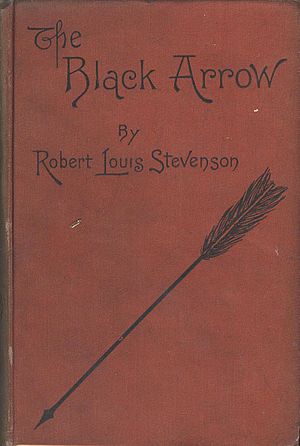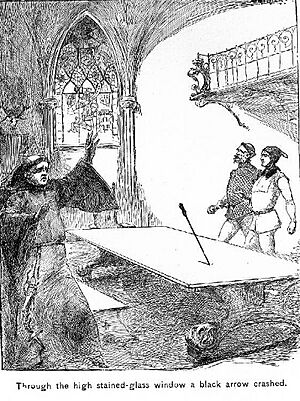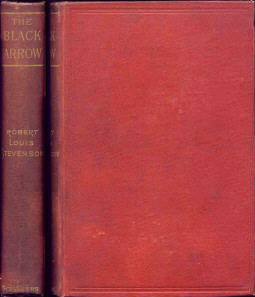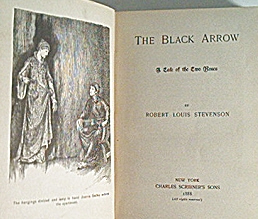The Black Arrow: A Tale of the Two Roses facts for kids
 |
|
| Author | Robert Louis Stevenson |
|---|---|
| Country | United Kingdom |
| Language | English |
| Genre | Historical, Adventure, Romance novel |
| Publisher | Charles Scribner's Sons (US) & Cassell (UK) |
|
Publication date
|
1888 |
| Media type | book |
| Pages | 392 (first edition) |
| Preceded by | serial periodical article |
The Black Arrow: A Tale of the Two Roses is an exciting historical adventure novel written by Robert Louis Stevenson. It was first published in 1888. The story is also a romance, filled with love and danger. Before it became a book, it was released in parts in a magazine called Young Folks in 1883. Stevenson used a secret name, Captain George North, for these early parts. The book is about 80,000 words long.
Contents
What the Story is About
The Black Arrow takes place during a real historical conflict called the Wars of the Roses. This was a time when two powerful families, the Lancasters and the Yorks, fought for control of England. The story follows a young man named Richard Shelton, also known as Dick. He wants to become a knight and find out who murdered his father, Sir Harry Shelton.
Dick also needs to rescue a young lady named Joanna Sedley. A group of outlaws in Tunstall Forest, led by Ellis Duckworth, use a special weapon: a black arrow. These outlaws make Dick suspect that his guardian, Sir Daniel Brackley, was involved in his father's death. Because of his suspicions, Sir Daniel turns against Dick. This forces Dick to escape and join the Black Arrow outlaws. His fight against Sir Daniel pulls him into the bigger war happening around them.
Main Events of the Story
The story is set during the reign of King Henry VI, around the time of the Wars of the Roses (1455–1487). It begins at Tunstall Moat House. An alarm bell rings to call people to fight in the Battle of Risingham. At the same time, a group of outlaws called "the Black Arrow" starts attacking. They use four black arrows to target four people: Sir Daniel Brackley, Nicholas Appleyard, Bennet Hatch, and Sir Oliver Oates.
A message left by the outlaws makes Dick Shelton wonder about his father's death. Dick is Sir Daniel's ward, meaning Sir Daniel is his guardian. Dick is sent to Tunstall Moat House. On his way, he meets a girl named Joanna Sedley. She is disguised as a boy named John Matcham. Sir Daniel had kidnapped Joanna because she was rich. He wanted to control her money and force her to marry Dick.
As they travel through Tunstall Forest, Joanna tries to convince Dick to join the Black Arrow outlaws. They even find the outlaws' camp. The next day, they meet Sir Daniel himself, disguised as a sick man, returning from a battle his side lost. Dick and Joanna follow him back to the Moat House. There, Dick finds proof that Sir Daniel murdered his father. Dick escapes the Moat House, even though he is injured. The Black Arrow outlaws rescue him.
The second part of the book is about Dick rescuing Joanna from Sir Daniel. He gets help from both the Black Arrow outlaws and the Yorkist army. This army is led by Richard Crookback, who will later become King Richard III. The action mainly happens in a town called Shoreby, where the Lancastrian forces are hiding.
Dick and the outlaws try to rescue Joanna from a ship, but they fail. After Joanna is moved to Sir Daniel's house in Shoreby, Dick visits her. He pretends to be a Franciscan friar. To escape from a sea captain named Arblaster, whose ship Dick had stolen, Dick tells the story of Ali Baba.
While watching Sir Daniel, Dick and the outlaws meet another group of spies who are also interested in Joanna. After a fight, Dick discovers he has captured Joanna's real guardian, Lord Foxham. Lord Foxham promises Dick that he can marry Joanna if they rescue her. Lord Foxham is wounded in the failed rescue attempt. He writes letters for Dick to take to Richard Crookback, who is outside Shoreby.
Richard Crookback, the Duke of Gloucester, appears in the final part of the story. As Dick leaves Shoreby, he sees Crookback fighting several enemies alone. Dick helps him win. Dick's knowledge of the Lancastrian forces helps Crookback win a big battle that day. Dick also does well as one of Crookback's commanders. Crookback makes Dick a knight on the battlefield. After their victory, he gives Dick fifty horsemen to chase Sir Daniel, who escaped with Joanna. Dick rescues Joanna but loses his men. He, Joanna, and Alicia Risingham travel to Holywood, where Dick and Joanna get married. This fulfills Dick's promise to Joanna to take her safely to Holywood.
On his wedding day, Dick meets Sir Daniel again. Sir Daniel is trying to escape to France. Dick doesn't want to fight on his wedding day. He simply blocks Sir Daniel's path, offering him a fight or warning the Yorkist soldiers. Sir Daniel retreats but is shot by Ellis Duckworth, the Black Arrow captain, with the last black arrow. After this, Sir Richard and Lady Shelton live peacefully at Tunstall Moat House. They are not bothered by the rest of the Wars of the Roses. They also help Captain Arblaster and the outlaw Will Lawless by giving them money and homes in Tunstall. Lawless even becomes a Franciscan friar again, taking the name Brother Honestus.
Main People in the Story
Here are some of the important people you'll meet in The Black Arrow:
- Richard (Dick) Shelton – He is the main character. Dick is the son of the late Sir Harry Shelton and the heir to Tunstall. He is almost 18 years old and has brown skin and grey eyes. He becomes a leader for the Black Arrow outlaws. Richard is made a knight by Richard Crookback.
- Clipsby – A peasant from Tunstall who first tells Dick that his guardian, Sir Daniel, might not be honest.
- Bennet Hatch – A loyal helper of Sir Daniel Brackley. He is a tough, grizzled man.
- Nicholas Appleyard – An old soldier, over 70, who fought in a famous battle called Agincourt.
- Sir Oliver Oates – The local church leader and Sir Daniel's clerk. He is a large, red-faced man who is often scared and does whatever Sir Daniel wants.
- Sir Daniel Brackley – The main bad guy. He is a selfish knight who often changes sides in the war to gain more money and land. He is known for being merry but is also very greedy and tricky.
- Joanna Sedley – The heroine of the story. She is 16 years old and is kidnapped by Sir Daniel. She first appears disguised as a boy. Later, she is described as tall and graceful.
- Will Lawless – An outlaw who is part of the Black Arrow group. He is a big man who loves to drink. He used to be a sailor and a friar. He helps Dick visit Joanna by dressing him as a friar.
- Ellis Duckworth – The leader of the Black Arrow group. He started the group to get revenge for Harry Shelton and others.
- Lord Foxham – A local lord who is Joanna Sedley's true guardian. He joins Dick and the outlaws to try and rescue Joanna.
- Richard Crookback – This is Richard Plantagenet, the Duke of Gloucester, who later becomes King Richard III. He is a real historical person. In the book, he is shown as a strong leader, even though he is young.
Time and Place of the Story
The story of The Black Arrow happens in two main time periods: May 1460 and January 1461. The author, Robert Louis Stevenson, mentions the Battle of Wakefield, which happened on December 30, 1460. This helps us understand the timeline.
Stevenson took some creative liberties with history. For example, Richard Crookback (the future Richard III) was only 8 years old in 1461. But in the book, he is shown as an adult fighting in the war. Stevenson did this to make the story more exciting, following how William Shakespeare also wrote about Richard III.
The Battle of Shoreby, a big fight in the book, is made up. But it is based on a real battle called the First Battle of St Albans during the Wars of the Roses. Both battles were won by the Yorkist side.
The place names in the book, like Tunstall, Kettley, and Shoreby, are based on real places in Suffolk, England. Stevenson visited Suffolk in 1873. Tunstall, where Dick Shelton lives, is a real village with a forest nearby. The River Till in the book is likely the River Deben in real life.
The main character, Richard Shelton, shares a name with a real historical person, Sir Richard Tunstall. However, the real Sir Richard Tunstall fought for the Lancasters, while the character Dick Shelton fights for the Yorkists.
Film and TV Versions
The Black Arrow has been made into movies and TV shows many times. Sometimes, these adaptations change the story quite a bit. Here are some of them:
- A short film in 1911.
- A movie in 1948 starring Louis Hayward.
- A two-part British TV show in 1951.
- An Italian TV show called La freccia nera in 1968.
- A British TV series that ran from 1972 to 1975.
- A film in 1985 starring Oliver Reed.
- A Soviet film called Chyornaya strela in 1985.
- An animated version by Burbank Films Australia in 1988.
Images for kids
See also
 In Spanish: La flecha negra para niños
In Spanish: La flecha negra para niños




